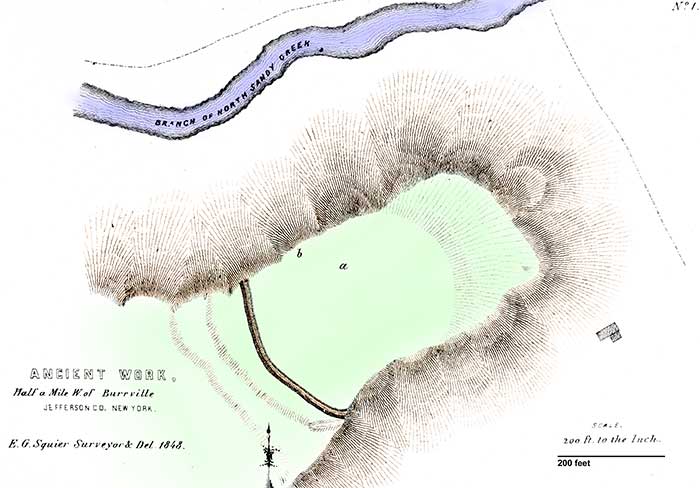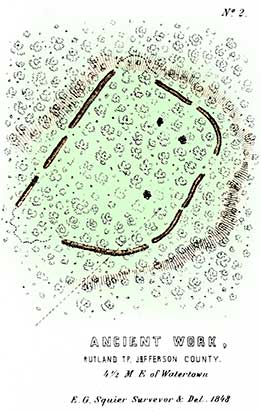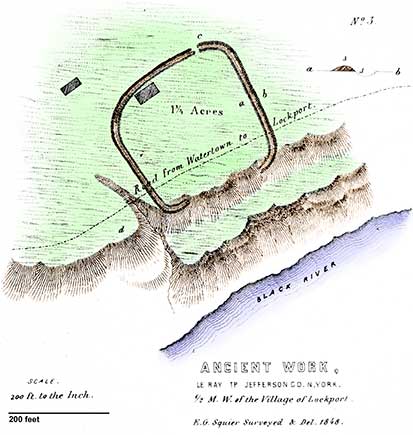
PLATE III. No. 1.
ANCIENT WORK; HALF A MILE WEST OF BURRVILLE, NEAR WATERTOWN, JEFFERSON COUNTY, NEW YORK.
A work, differing somewhat from those before described, is situated two miles north of the enclosure last noticed, upon a high promontory or headland, half a mile west of the little village of Burrville. The northern base of this promontory is washed by a small and rapid stream, a branch of the east fork of Sandy Creek. Deep ravines lend strength to the position on the remaining sides, except towards the west, where it joins the highlands. Here, extending across the neck of the promontory, (the only direction from which access is easy,) was formerly an artificial defence, consisting of an embankment of earth and a trench. The plough has filled the one and leveled the other, but the lines can still be accurately traced by attending to the various circumstances already repeatedly mentioned. At the part marked a, was formerly a large deep pit, resembling the cellar of a dwelling house. At b, was also an accumulation of large stones, bearing traces of fire; and which the early settlers, indulging in vague notions of the mineral wealth of the country, called "the Furnace."
Most of these stones were used to fill the pit near by; but enough still remain to mark the site of the supposed "furnace." Whenever the land of this work is ploughed over, many relics of art are disclosed, fragments of pottery, broken pipes, implements of stone and bone, beads of similar materials, etc., etc.
About a mile northeast of this place, upon a fine level tract of ground, are the traces of an aboriginal village. Rude fireplaces, constructed of rough stones huddled together, and surrounded by carbonaceous accumulations, sometimes two feet deep, mark the site of the ancient lodges. These indications are numerous. Here, too, are to be found relics, entirely corresponding with those already noticed, as occurring within and around the ancient enclosures.
PLATE III. No. 2.
ANCIENT WORK, RUTLAND TOWNSHIP, JEFFERSON COUNTY, NEW YORK.
The slightest and much the rudest structure discovered in Jefferson county, is the one here delineated. It is situated about a hundred rods back from the brow of the terrace, already so often referred to, and which here rises abruptly from the inferior level, presenting a bold, and in some places, a precipitous bank.
Notwithstanding its elevation, this terrace has numberless depressions or basins, which are wet and marshy. Upon a slight elevation, in the midst of one of these, and still covered with a primitive forest, is the work in question. It will be observed that it is exceedingly irregular, and that the lines are interrupted by several wide openings, which are quite too broad to be regarded as gateways.
The embankment is not of uniform dimensions. In some places it is elevated but a foot or eighteen inches, by four or five feet base, while in others it is perhaps three feet in height. The ditch is also irregular,—in sections scarcely exceeding a large plough furrow in depth and width. In fact, the work seems imperfect, and to have been constructed in haste for temporary purposes. Within the area, which is quite uneven, are several small accumulations of stones, which bear the marks of fire. Upon removing some of them, the proprietor of the ground found ashes and other burnt matter, amongst which was a carbonized ear of maize. A small but entire vessel of pottery, of considerable symmetry of shape, was also found here some years since.
Human bones have been discovered beneath the leaves; and in nearly every part of the trench skeletons of adults of both sexes, of children, and infants, have been found, covered only by the vegetable accumulations. They seem to have been thrown together promiscuously. They have also been found in a narrow depression resembling an artificial trench, indicated by a dotted line in the plan, and caused by the subsidence of the earth in a cleft of the limestone substratum. These skeletons, from all accounts, do not seem to have been much decayed, and no difficulty was experienced in recovering them entire. The skulls were in some cases fractured, as if by a blow from a hatchet or club. These circumstances would seem to imply, not only that the work is of comparatively late construction, but also that this was the scene of one of those indiscriminate massacres so common in the history of savage warfare.
From the bank of the terrace, near this work, a very extensive and beautiful prospect is commanded.
PLATE III. No. 3.
ANCIENT WORK HALF A MILE WEST OF LOCKPORT, JEFFERSON COUNTY, NEW YORK.
The remaining works of Jefferson county, so far as investigated, are situated on lower grounds, generally near streams, which are made subservient to art for purposes of defence. The work here presented is a good example. It is situated on Black River (Kā-me-hārgo), in Le Ray township, half a mile below the little manufacturing town of Lockport. The banks of the river are here very high, and quite inaccessible. The character of the work is well shown in the engraving, and needs little explanation beyond what that affords. It will be seen that the ends of the embankment extend for a short distance down the slope of the river bank, and then curve slightly inwards, as though designed to prevent the flanks being turned by an enemy. The lines, where they cross the road, and between the road and the river, are very distinct, and the embankment is between three and four feet in height. The rest of the work may be traced without much difficulty, although it has long been under cultivation. Upon the wall, at the point indicated by the letter c, is still standing a pine stump, upwards of three feet in diameter, probably having an age of not less than four hundred years. The usual relics are found within the area of the enclosure; and in the natural bank at d, a number of skeletons have been disclosed by the plough. They are much decayed, but in respect of position correspond with those found elsewhere in Indian cemeteries.



